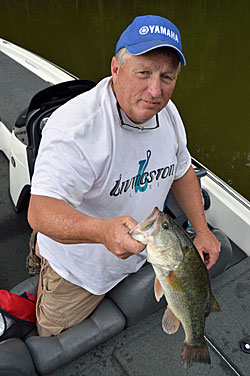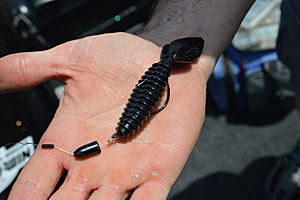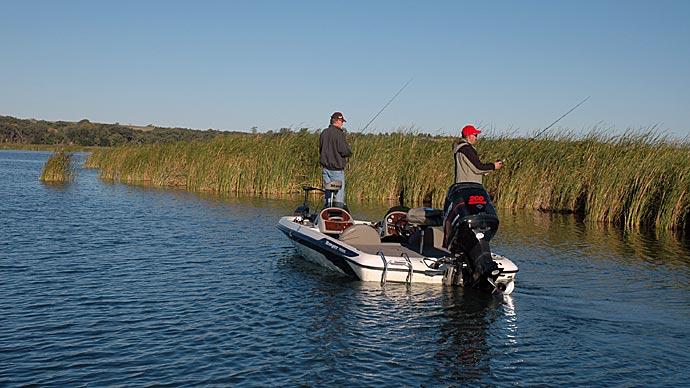
It was a tough couple of fishing days on New York’s Hudson River. I landed a few largemouths and token stripers on buzzbaits and Texas-rigged soft plastics but not enough to do anything in the upcoming tournament, my first on the tidal fishery. Dejected, I refocused on learning as much as possible from my partners. The biggest lesson came on the final day of the event.
That morning my boater raced to one of the many bridges that carry train tracks between Albany and New York City along the river’s eastern bank. The outgoing tide pulls water into the river from the backwaters on the other side of the tracks. That current sets the table twice daily for many of the river’s plentiful smallmouth. But unlike me, my fishing partner was serving what they wanted.
He would cast his Carolina rig, consisting of a light weight about 15 inches ahead of a 4-inch finesse worm, under the bridge and pull it downstream, letting the current float, twist, and shake his lure just above the bottom. It perfectly matched the hatch and several smallmouth bits. My Texas-rigged worm sat squarely on the bottom and lacked the same appeal.
While the Carolina rig shined this day, there are days when a Texas rig is the top producer. Like all bass-fishing techniques, these rigs are tools and knowing how, where, and when to use each means more bass in your boat and opens doors to other techniques. Drop shots, floating worms, stick worms, such as Senkos, and even soft-plastic frogs use Texas rigging. The Carolina rig has its disciples, including the split-shot rig.
What to rig

Texas and Carolina rigs are best at presenting soft-plastic lures. Grubs, worms, lizards, soft jerkbaits — there isn’t one that can’t be fished on either rig. Deciding which one depends on how much action you want your lure to make and the conditions you are fishing.
Take a Texas-rigged punch bait, for example, which are the rage during the winter in Florida and the rest of the year everywhere else you find heavy matted vegetation. They need to be slim to slip through the stems of vegetation you are fishing. Their appendages or tails need to be few or small, so they don’t grab grass and keep the rig from reaching the bottom. It can be a great situation to rig a tube but leave the swimming tails for more open water. The same reasoning can be used for picking a lure for your Carolina rig. Lizards, for example, are probably the best-known Carolina-rigged lure. Their tail and four feet create lots of action with each pull of your rod. But when the cover is scattered, and bass are in a neutral mood, less action can produce more. This is when you’re better off with a stick worm, whose slow glide can convince bass to bite.
Lures are rigged Texas-style on both rigs. To do that, insert the hook point about a quarter-inch into the center of the lure’s head. Turn the point 90 degrees, so it exits the worm along one of the mold lines, which run down the sides of the lure. Use it as a guide to keep the lure straight on the hook, preventing line-twisting spirals while it’s retrieved. Pull the hook through until the knot is buried in the lure’s head. Rotate the hook 180 degrees, so the point is facing the lure. Using your thumb and forefinger, mark where the hook bend lines up with the lure. Push the lure forward, kinking it, until that spot lines up with the point. Insert it at the mold line, pull the lure back until it’s straight, and the point is buried in the plastic.
“Texposed” is a popular variation of this rigging style. Start as before, but push it through the other side when you re-insert the hook point. Then tuck it back into the plastic. It’s weedless, but there is less plastic when setting the hook. This works well when using lighter line because less force is needed to drive the hook out. It can be frustrating to use when you are fishing heavy cover, as it snags weeds or wood almost as easily as bass.
Carolina rigs aren’t restricted to soft plastics. They’ve been used to pull hard jerkbaits and crankbaits to depths deeper than their bills will dig. If you experiment with this option, make sure the lures are floaters or at least true suspenders. Slow sinking versions will only snag the bottom.
Assembling the rigs
The primary difference between Texas and Carolina rigs is the distance between the weight and the lure. On Carolina rigs, the lure can be from a few inches to several feet behind the weight. That length is determined by cover density. Longer leaders, for example, tend to get hung up more in thicker cover. The weight is kept ahead by a swivel that’s tied in the line. It doesn’t have to be an expensive ball-bearing swivel; a simple crane works perfectly. On Texas rigs, the weight rides directly in front of the lure. It can be pegged in place or left to slide free. In a pinch, you can turn a Texas rig into a Carolina rig by crimping a small split-shot on the line to keep the weight away from the lure.

Bullet-shaped weights make Texas rigs work. You’ll want to use the lightest weight while still feeling the lure on the bottom. Switching from a 3/16- to 1/4-ounce bullet sinker might not seem like a significant change, but on a windy day, it can make the difference in your lure getting into the cover or being dragged over it. Be mindful of how much action is built into your lure. Big action tails, for example, take more weight to activate than a straight-tail worm. Weights made of tungsten cost more, but the material’s density means sinkers are physically smaller than lead ones of equal weight. Tungsten’s hardness transmits the bottom composition better.
When casting a Texas rig, let the weight slide free. That will give your lure a more natural action. But you will want to peg it if you are pitching or flipping it into heavy cover. There’s almost nothing more frustrating than pitching your Texas-rigged lure to a piece of shallow cover and watching the weight wrap around one part and the lure another. To peg the weight, you can go the old-fashioned route and wedge a piece of a toothpick in the underside of the weight’s line hole. There also are the tapered rubber ribbons that slide along the line. The most popular method is adjusting bobber stops or similar-looking stops marketed specifically for pegging weights. They also offer a chance to add attraction to your rig.
Inserting a glass rattle into a soft-plastic lure was the best way to add bass-attracting sound. Then along came rattling sinkers, which worked but were expensive. Today it just takes a glass bead. After you slide the stop and weight on the line, add the bead. Leave about three-quarters of an inch of free play between the peg and weight. That will give it enough room to clack against the bead but not hang up.
Beads also are an essential part of Carolina rigs. They give off the same fish-attracting clack and protect a knot from the weight. The heavier the weight on your Carolina rig, the easier it will be to feel what it’s doing on the bottom and keep it there. The most popular sizes are ½- and ¾-ounce, but heavier ones have their place in deep water or heavy current. Bullet-shaped weights are best when Carolina rigging through aquatic grass or across sand or clay. Use an egg- or barrel-shaped weight if you want to drag one through stumps, wood, or rock. Its bulky shape will reduce the times it wedges in crevices.
Angler preference plays a significant role in the hook used on either rig. I prefer straight-shank ones, though if I’m spending too much time dealing with a lure that won’t stay up on the hook, I’ll switch to an offset-shank model. The most crucial consideration is hook size. Choosing one too small will translate into lost bass as the lure wads up and covers the point. Hooks that are too large add rigidity that kills action. For the most part, you’ll want a 1/0 hook for 4-inch worms, 3/0 for 6-inch lures, and 5/0 for those 8 inches or longer.
Choosing a rig

All the lures in your tackle box and techniques you’ve practiced are tools. They all catch the most bass when used in the situation for which they were designed. Choosing a Texas rig over a Carolina rig also comes down to that.
Texas rigs are compact. With the weight close to the hook and soft-plastic lure, they can be cast as quickly as they can be flipped or pitched. That compact size also means they are best suited for picking apart a piece of cover or structure, someplace where bass is hunkered down or concentrated. That can be pitching a weightless stick worm to a dock, working a 10-inch ribbon tail worm over a submerged rock pile, shaking a lizard in the sweet spot of a spawning bed, or doodling a finesse worm along an underwater bluff.
Reach for a Carolina rig when you want to cover water. The heavy weight allows for long, bombing casts. It lets the lure rise off the bottom and be moved by current or float over submerged grass. In New England waters, such as Lake Winnipesaukee in New Hampshire or Lake Champlain along the New York-Vermont line, anglers drag them over deep grass-covered humps to catch big bags of smallmouth bass.
Retrieves for each rig
Texas-rigged soft plastics can be dead sticked — letting the lure settle to the bottom on a semi-tight line without imparting any movement— or straight reeled, such as the way you fish the speed worms that New Jersey Bassmaster Elite Series angler Michael Iaconelli made famous with his 2003 Bassmaster Classic victory on the Louisiana Delta. In between, an infinite number of combinations of hops and pauses can be used. Ultimately, the bass will decide how much action your rig should have. Suppose you have found a deep school of bass, for example, which are only interested in eating a sinking soft-plastic lure. In that case, you should shorten the pauses and exaggerate the lifts, even bringing the rod’s handle above your head, to increase the time your lure falls on each retrieve.
It’s the same principle for Carolina rigs. When bass are active, you can fish them with a slow, steady retrieve, just as you would slow roll a big spinnerbait. Switch to pulls with pauses when bass are finicky. If you are fishing current, like that day on the Hudson River, you can let the water wash your rig along, right onto the plate of a waiting bass.




